Guide dogs can't see virtue signalling
How something quite pedestrian is being used to enforce gender ideology.
Earlier this week, Camden Council announced the opening of four pedestrian crossings painted in the pink and blue of the trans flag. They appear at the four-way junction of Tavistock Place and Marchmont Street and were installed to ‘celebrate Transgender Awareness Week’.


Such coloured crossings can pose a serious safety risk to elderly, disabled and visually impaired people, amongst others, and they confuse service animals such as guide dogs and police horses. There is also a risk that some drivers may not recognise them as pedestrian crossings.
Indeed, concern over the dangers posed by these crossings has so been great that London mayor, Sadiq Khan, called a halt to their installation a week prior to Camden Council’s announcement.
As reported in The Daily Mail, planning documents have revealed that Camden Council went ahead with these crossings despite concerned groups pointing out the dangers.
The Royal National Institute for the blind (RNIB) and Transport For London’s Independent Advisory Disability Group were consulted during the planning process and their concerns are recorded in the council’s Equality Impact Assessment form.
The RNIB advised that the coloured crossings would confuse and endanger blind and visually impaired people. “The use of black and white in traditional pedestrian crossings offer high contrast which is essential for people with low vision to detect them and stay on course when crossing roads.”
Transport For London’s Independent Advisory Disability Group warned that there are problems of ‘visibility and recognition’ for people of neurodiversity (such those with learning disabilities or dementia). The group also advised that people with sensory sensitivities on the Autism spectrum could suffer anxiety using these crossings.
Nevertheless, Camden Council ignored all the warnings and safety implications and forged ahead with the installation of the trans flag crossings.
Despite acknowledging in its own Equality Impact Assessment form that the crossings pose a risk to other sections of the community, the council deemed it more important to ‘celebrate transgender people’.
On several occasions this assessment form mentions providing ‘awareness of issues being faced by transgender people’. What those ‘issues’ are and how they can be communicated through the medium of lines painted onto asphalt, it does not explain.
Local councillor, Danny Beales, trumpeted the unveiling of the ‘trans flag crossing’ on social media and said it was ‘an honour to be involved’.
When people tried to point out the huge risks to various vulnerable groups, he demanded a first-hand on-site demonstration. (And turned off the replies.)
The Metro reported on this crossing in Camden. There is a marked difference between this story and its reporting on a similar crossing just a few months ago.
Transport For All is a disability rights group focusing exclusively on travel and transport. Rather than speaking out against these Camden crossings as other organisations have, TFA issued a statement implying that those expressing safety concerns are acting out of hatred and bigotry.


“We have been horrified to witness examples of disabled people and accessibility concerns being weaponised against other marginalised groups, specifically the LGBTQ+ community.”
This is a surprising response given that less than two months ago, TFA wrote an open letter to the Mayor of London, voicing serious concerns about these ‘colourful crossings’ and objecting to their installation.
“The provision of safe crossing points affects everyone’s ability and desire to use their local streets, and this is especially crucial in enabling disabled people to make journeys as a pedestrian… We have significant concerns about the safety and accessibility of these schemes.”
But when other groups or individuals raise the same concerns over a crossing in trans flag colours, they’re somehow hateful and bigoted and ‘weaponising’ the experiences of disabled people?
The rabid defence of these four pastel-coloured crossings in Camden demonstrates one thing very clearly; that trans activism demands complete subservience and no form of dissent, even concerns about the safety of vulnerable people, can be tolerated.
For me these crossings are not just a danger and a waste public money; they symbolise the imposition of a totalitarian belief system, adherence to which is not just assumed, but rigidly enforced. And who cares if a few vulnerable people are put in danger as a consequence?




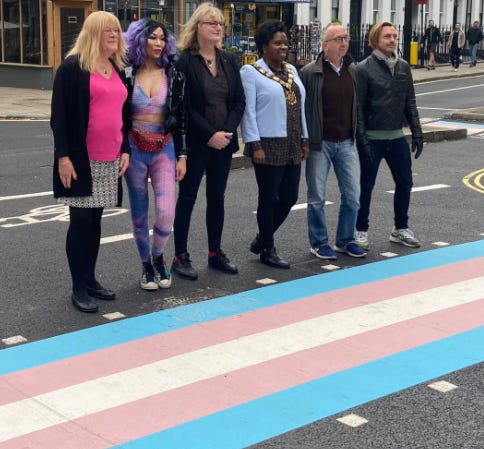
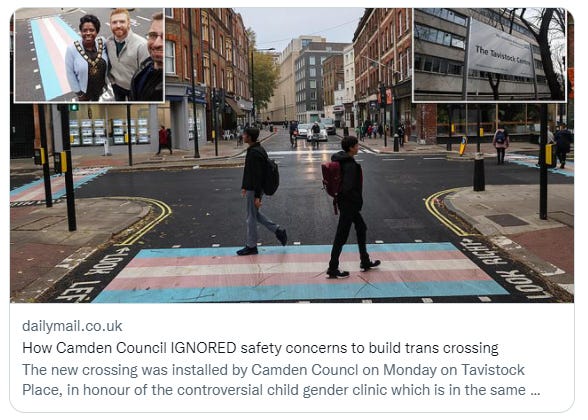
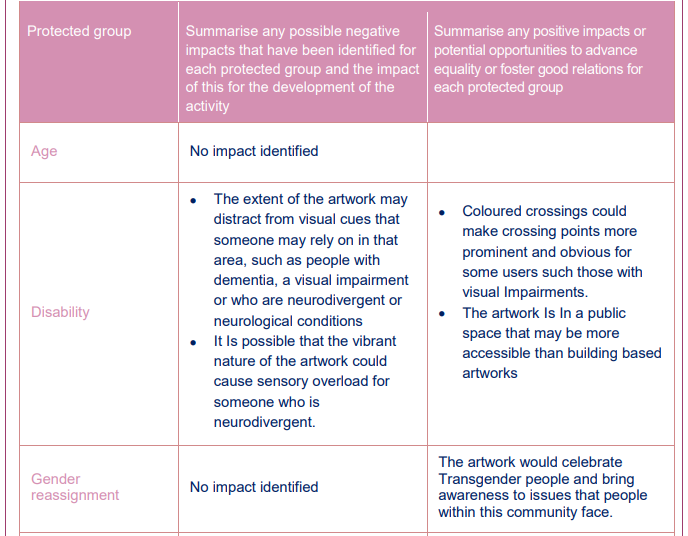
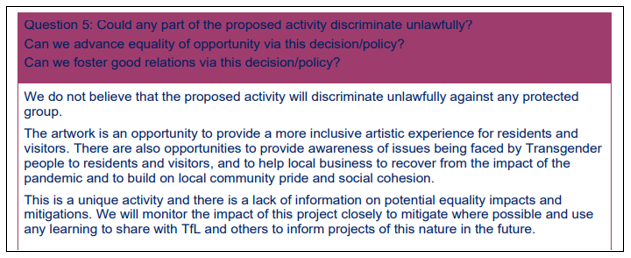
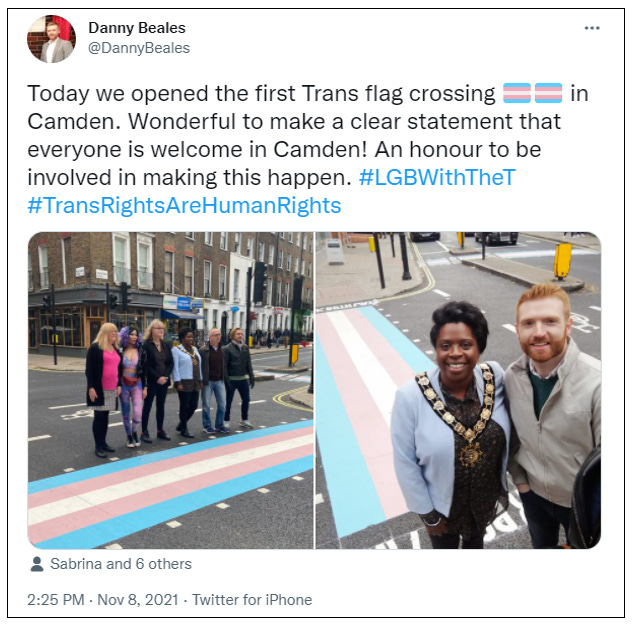
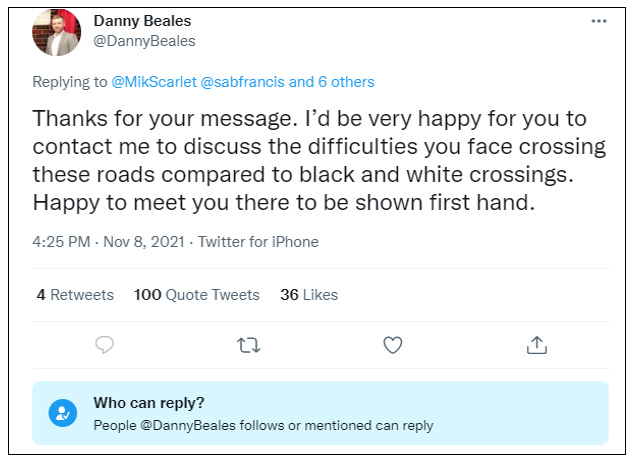
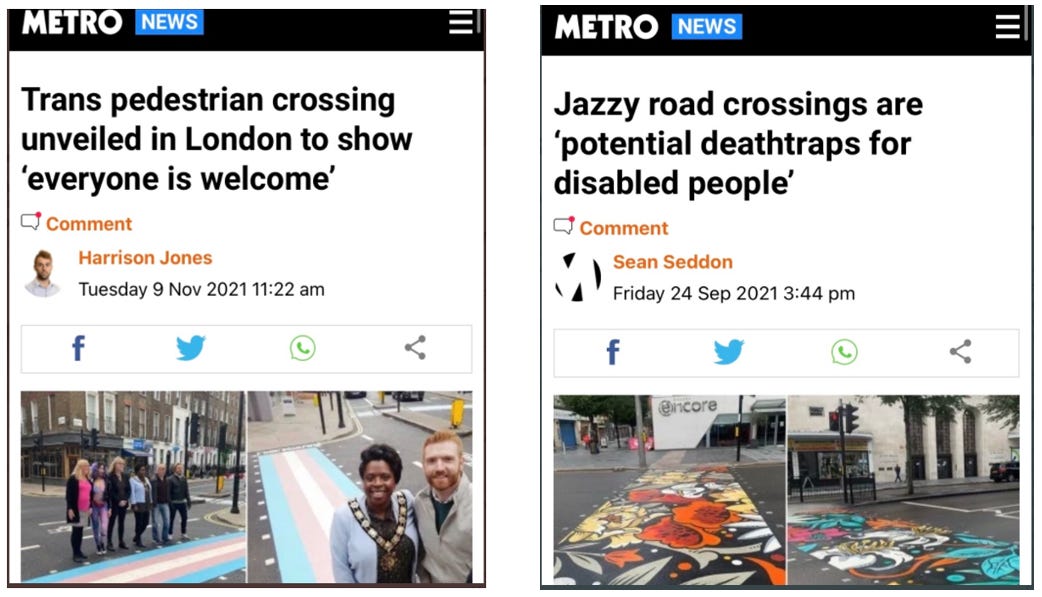
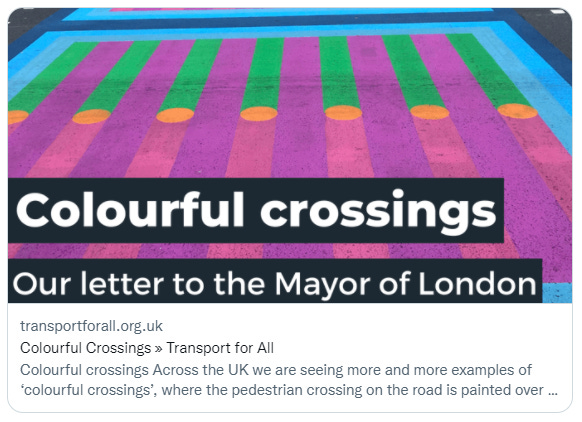

Interesting that they reference "accessibility to artwork". Road crossings are not artwork. They are pragmatic safety measures, just like sex segragated toilets and changing rooms are. They exist to serve basic public needs for practical purposes. They are not blank canvases for "artwork" ie propaganda. In totalitarian systems, everything is politicised. And when disabled people, women and girls can't participate in society safely then we are not included in society. That appears to be the very purpose of "inclusivity".
When your ideology is happy to send the vulnerable into moving traffic, yet regards using correctly sexed pronouns as "literal violence" it's time to have a word with yourself.